Spring Narcissi and Pollen
Germination
Chris Thomas, UK
Oh Joy! Winter had started to loosen its
dank cool grip on East Anglia. A prolonged spell of warmer
weather in March brought out the daffodils in their myriad forms
even before the snowdrops had finished blooming. The first
bumblebees had hardly emerged sleepily from their hibernation,
but already a long legged figure could be seen flitting from Narcissus
to Narcissus. Yes it was I, the dreaded anther-snatcher
of Cambridge!
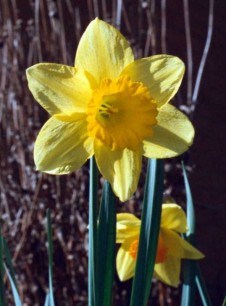 The
most recent bee in my bonnet has been the germination of pollen
on slides. The interest being that with some flower species this
is easy and with others it is not. For reasons peculiar to the
warped mind of an amateur microscopist, I had previously shown
that germination of pollen was greatly enhanced on onion
epidermis. Indeed, a fellow enthusiast, John Garrett, found the
method worked well and gives an excellent description of the
finer arts of the procedure in an earlier
article. So whilst a flock of
golden daffodils inspired one man to poetry, it inspired me to
pollen collection.
The
most recent bee in my bonnet has been the germination of pollen
on slides. The interest being that with some flower species this
is easy and with others it is not. For reasons peculiar to the
warped mind of an amateur microscopist, I had previously shown
that germination of pollen was greatly enhanced on onion
epidermis. Indeed, a fellow enthusiast, John Garrett, found the
method worked well and gives an excellent description of the
finer arts of the procedure in an earlier
article. So whilst a flock of
golden daffodils inspired one man to poetry, it inspired me to
pollen collection.
Golden variety of
garden narcissus with a trumpet as long as the outer petals.
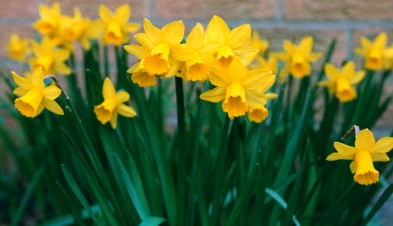 Dwarf narcissi 'Tete a tete'
Dwarf narcissi 'Tete a tete'
The narcissi were almost
spared this treatment as I first tried the dwarf variety Tete
a tete which bloomed early in our back garden. The pollen
did not germinate well or at all on the three occasions tried.
Many of the grains actually seemed empty, possibly sterile.
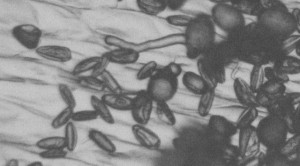 Poorly
germinating pollen as found in pure golden large and dwarf
narcissi (100x mag)
Poorly
germinating pollen as found in pure golden large and dwarf
narcissi (100x mag)
The fatal mistake was to try
looking at a range of different narcissi in our garden. The large
golden form behaved much like the dwarf versions, poor
germination and many unexpanded grains.
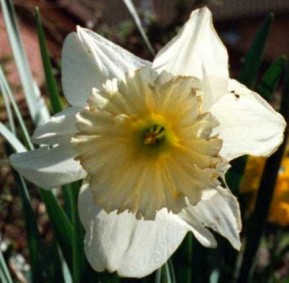 However,
the pollen from a white form and from a bicoloured flower
germinated very efficiently as you can see below.
However,
the pollen from a white form and from a bicoloured flower
germinated very efficiently as you can see below.
But was this a real result? Or
was nature playing tricks with me? A larger sample was called for
and many clumps of nodding narcissi beckoned invitingly on the
cycle ride to and from work. A fear of righteous citizens,
perhaps armed with leaded handbags or pointed umbrellas, did set
a note of caution into my planning. Picking whole flowers to take
home seemed too much like an act of vandalism!
White narcissus
with trumpet as long as outer petals
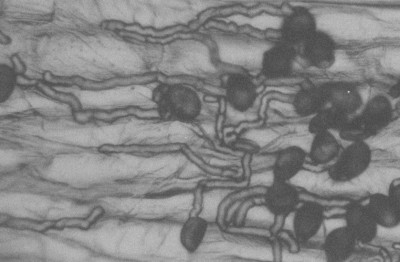 Typical pollen germination with white or
bicoloured flowers (100x mag)
Typical pollen germination with white or
bicoloured flowers (100x mag)
Just picking an anther and
leaving the flowers otherwise intact seemed a safer bet and so,
armed with my trusty forceps, I meandered from flower clump to
flower clump on my way home from work. It is a measure of the
English inclination to permit harmless eccentricity without
question, that my obvious activity drew only one polite enquiry
from passers by!
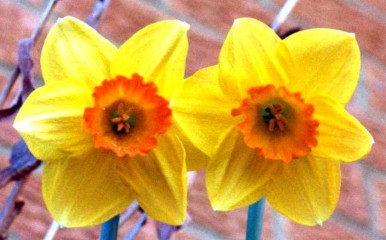 Bicoloured
flowers, trumpet shorter than petals, which showed good pollen
germination
Bicoloured
flowers, trumpet shorter than petals, which showed good pollen
germination
A large onion was sacrificed
for its epidermis in the pursuit of higher knowledge rather than
a more mundane culinary application. Three hours later I had my
confirmation! Individual flowers from the same clump of plants
behaved alike. Flowers from separate clumps appeared to germinate
according to the above pattern - golden narcissi were poor pollen
germinators whilst the white and bicolour forms tried had
excellent pollen germination.
Why this might be, I do not
know! Perhaps someone out there on the worldwide web does and
could let me know? You can reach me by e-mail at Chris.
If you are interested in
trying out pollen germination for yourself, John Garret gives an
excellent demonstration in the earlier
article. If you really get the bug
then send your results to me at my e-mail address (see above)
following the procedure on pollen2 -
Chris. If we gather sufficient
information, I will try to get the information published!
So what am I going to do now?
Well, on the way into Cambridge I couldn't help noticing all
those lovely cherry trees in bloom, pink, white, single or double
flowered. I wonder how their pollen behaves?........
© Microscopy UK
or their contributors.
Published in the
April 2000 edition of Micscape Magazine.
Please report any
Web problems or offer general comments to the Micscape Editor,
via the contact on current Micscape Index.
Micscape is the
on-line monthly magazine of the Microscopy UK web
site at Microscopy-UK
WIDTH=1
© Onview.net Ltd, Microscopy-UK, and all contributors 1995 onwards. All rights
reserved. Main site is at www.microscopy-uk.org.uk with full mirror at www.microscopy-uk.net.
 The
most recent bee in my bonnet has been the germination of pollen
on slides. The interest being that with some flower species this
is easy and with others it is not. For reasons peculiar to the
warped mind of an amateur microscopist, I had previously shown
that germination of pollen was greatly enhanced on onion
epidermis. Indeed, a fellow enthusiast, John Garrett, found the
method worked well and gives an excellent description of the
finer arts of the procedure in an earlier
article. So whilst a flock of
golden daffodils inspired one man to poetry, it inspired me to
pollen collection.
The
most recent bee in my bonnet has been the germination of pollen
on slides. The interest being that with some flower species this
is easy and with others it is not. For reasons peculiar to the
warped mind of an amateur microscopist, I had previously shown
that germination of pollen was greatly enhanced on onion
epidermis. Indeed, a fellow enthusiast, John Garrett, found the
method worked well and gives an excellent description of the
finer arts of the procedure in an earlier
article. So whilst a flock of
golden daffodils inspired one man to poetry, it inspired me to
pollen collection. Dwarf narcissi 'Tete a tete'
Dwarf narcissi 'Tete a tete' Poorly
germinating pollen as found in pure golden large and dwarf
narcissi (100x mag)
Poorly
germinating pollen as found in pure golden large and dwarf
narcissi (100x mag) However,
the pollen from a white form and from a bicoloured flower
germinated very efficiently as you can see below.
However,
the pollen from a white form and from a bicoloured flower
germinated very efficiently as you can see below. Typical pollen germination with white or
bicoloured flowers (100x mag)
Typical pollen germination with white or
bicoloured flowers (100x mag) Bicoloured
flowers, trumpet shorter than petals, which showed good pollen
germination
Bicoloured
flowers, trumpet shorter than petals, which showed good pollen
germination